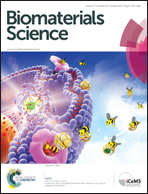Inspired and stabilized by nature: ribosomal synthesis of the human voltage gated ion channel (VDAC) into 2D-protein-tethered lipid interfaces
Abstract
We present an elegant synthesis and reconstitution approach for functional studies of voltage responsive membrane proteins. For such studies, we propose a planar architecture of an S-layer-supported lipid membrane as a suitable matrix for presenting unmodified membrane protein species, and here we focus on the voltage-dependent anion channel (VDAC) from human mitochondria. The presented cell-free strategy, in which VDAC proteins are synthesized in bacterial cell lysate, into a membrane structure, offers a great advantage in the study of such subtle membrane proteins over the conventional, cell-based synthesis approach in terms of reproducibility. The material–assay combination is superior over cell-culture related synthesis and purification approaches as here we bypass by a one-step synthesis procedure the complex cell culture, and expression and purification endeavours, and, moreover, the protein of interest never has to be detergent solubilized and had been synthesized de novo. We provide here a detailed description from the all over procedure and our first results, describing in detail the cell-free synthesis and robustness of such a material–assay combination: functional VDAC protein species embedded in a planar membrane architecture and ready for electrochemical characterization.


 Please wait while we load your content...
Please wait while we load your content...